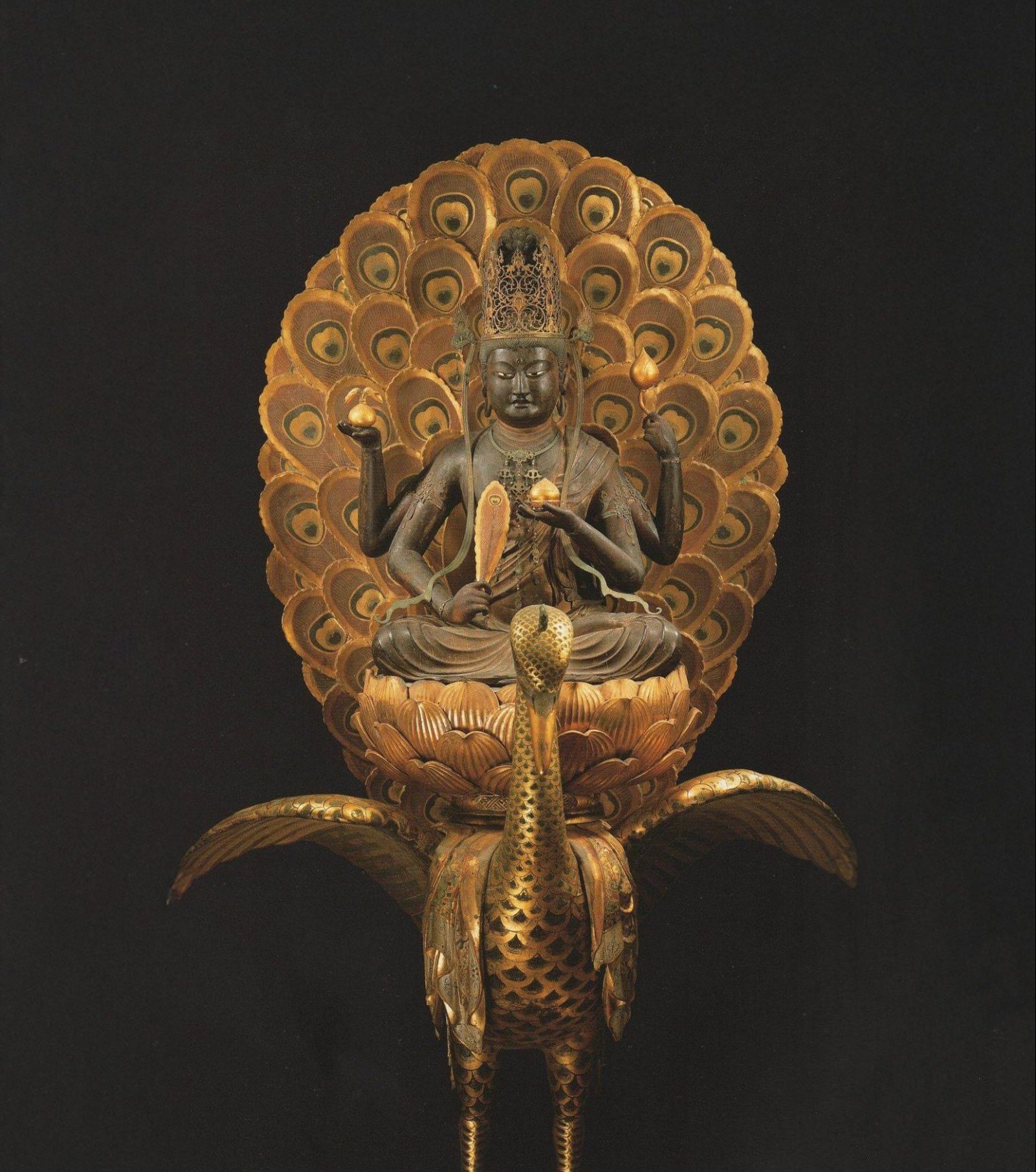Translated By Tony Qin
The Buddha Mother Great Peacock King Sutra primarily consists of mantras and the names of various Buddhas, bodhisattvas, dragon kings, and deities, with relatively little text dedicated to explaining its teachings. Let us begin by exploring the origins of this sutra and the wisdom it offers.
The main text of this sutra begins as follows:
“Thus have I heard: At one time, the Bhagavan was staying in the city of Śrāvastī, in Jeta’s Grove, the garden of Anāthapiṇḍika. At that time, there was a bhikṣu named Śāṭi who had recently been ordained, received his full monastic vows, and was studying the Vinaya teachings. While gathering firewood and preparing water for the monastic community’s bath, a large black snake suddenly emerged from a hole in a rotting log and bit him on the big toe of his right foot. The venom spread through his body, causing him to collapse to the ground, unconscious, with foam at his mouth and his eyes rolled back.
When the venerable Ānanda saw Śāṭi suffering from the effects of the poison, he hurried to the Buddha, bowed at his feet, and said, ‘World-Honored One, the bhikṣu Śāṭi has been bitten by a venomous snake and is in great suffering. Out of your great compassion, what can be done to save him?’”
The sutra recounts that while the Buddha was residing in Śrāvastī at Jeta’s Grove[1], a monk named Śāṭi, who had recently been ordained, was tasked with gathering firewood and preparing water for the monks’ baths. On one occasion, a large black snake emerged from a hole in a rotting log and bit him on the big toe of his right foot. The venom quickly spread throughout his body, causing Śāṭi to collapse to the ground, unconscious, with foam at his mouth and his eyes rolled back, hovering on the brink of death. When Ānanda saw this, he immediately went to inform the Buddha.
“At that time, the Buddha told Ānanda, ‘I have the Mahāmāyūrī Buddha Mother Wisdom King Mantra, which possesses great power. It can dispel all poisons, eliminate fears and disasters, and protect and nurture all sentient beings, bringing them peace and happiness. You should recite this Buddha Mother Wisdom King Mantra for Śāṭi, the bhikṣu, to save him. It will establish boundaries, secure the four corners, and bring stability, eliminating all afflictions and suffering.’“
The bhikṣu Śāṭi represents all of us, suffering beings. His being bitten by the venomous snake symbolizes how we are stung by the three poisons—greed, anger, and ignorance. Without the Buddha’s protection, the poison would be fatal. In that moment, Venerable Ānanda rushed to the Buddha, seeking guidance on how to provide salvation, asking how to alleviate the suffering of beings overwhelmed by these three poisons. It is from this very cause that the Buddha revealed this sutra and its root mantra to the world.
“The Buddha said to Ānanda, ‘In times long past, on the southern slopes of the Snow Mountain, there lived the Golden Radiance Peacock King. Every morning, he would recite the Buddha Mother Great Peacock Wisdom King Mantra. During the day, he was always at peace, and at night, he would recite it again, ensuring tranquility.
One day, however, he forgot to recite the Buddha Mother Great Peacock Wisdom King Mantra. He then went with a group of peacocks and their consorts, wandering from forest to forest, from mountain to mountain, indulging in playful desires and cravings. Lost in heedlessness and delusion, they entered a cave where hunters had set traps. Soon, the Peacock King was caught in a bird’s snare.
At the moment of being captured, the Peacock King suddenly remembered his original mindfulness. He immediately began to recite the Buddha Mother Great Peacock Wisdom King Mantra. As he chanted, the bonds naturally loosened, and he was freed. His family and followers were safe and sound, and they returned to their dwelling. Once there, the Peacock Wisdom King recited the mantra once more, saying (the root mantra)…’”
The sutra uses the Peacock King’s experience as a metaphor for beings in the Six Paths of Existence. It illustrates how, due to “desires and cravings… heedlessness and delusions,” sentient beings fall into the three lower paths, enduring eons of suffering. “At that moment of being captured, the Peacock King suddenly remembered his original mindfulness”; the suffering of sentient beings in the cycle of birth and death can only be overcome through hearing the Buddha’s Dharma, which enables them to find their way back and, through diligent practice, ultimately attain liberation.
When the Peacock King faced imminent danger, he was able to recall and recite the root mantra, which led to his escape. What lesson does this offer us? Sentient beings often live heedlessly, indulging in greed, anger, and ignorance, accumulating negative karma without realizing it. This leads them into suffering and degradation. It is only when they find themselves in dire circumstances, facing the consequences of their wrongdoings, that they recall their true mind and urgently seek liberation. This is the inherent nature of beings in the six paths.
From this, we can see that we, as beings of the Dharma-Ending Age, have shallow spiritual faculties and are easily confused by distractions and obstacles. With our weak inner strength, we must rely on the Buddha’s power, which in turn awakens our own inner power. We must remain steadfast in our practice at all times. By aligning the Buddha’s power, the Dharma’s power, and our own inherent power, we can distance ourselves from calamities, avoid misfortune, and progress toward the path of awakening.
[1] Jeta’s Grove in Śrāvastī, located on the southern outskirts of the city of Śrāvastī in Uttar Pradesh, India, was a significant site where the Buddha expounded his teachings. It was also the largest monastery during the Buddha’s lifetime.

